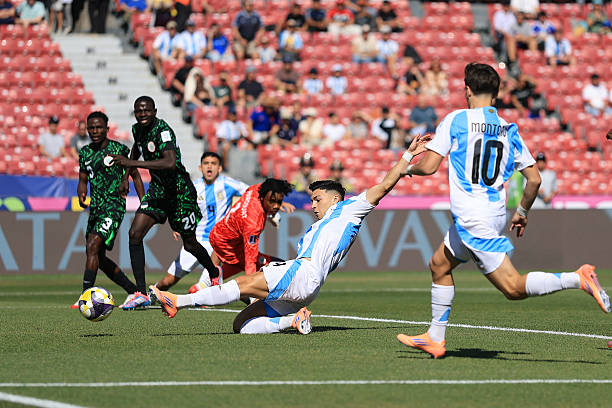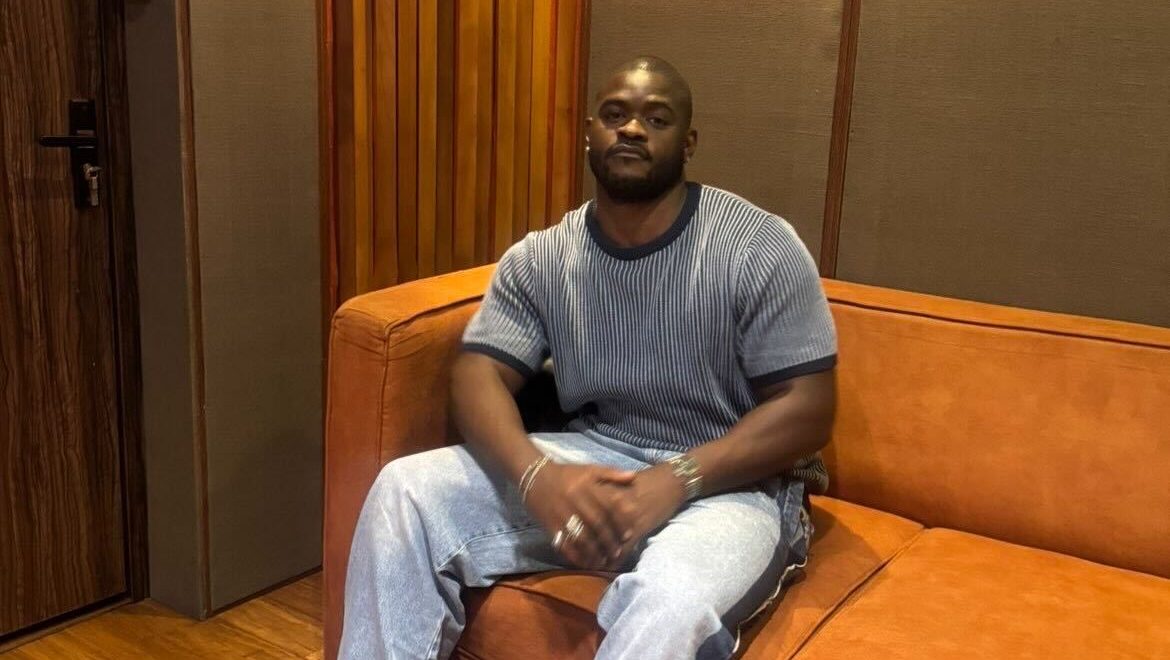By Johnson Opeisa
“Within just seven months, the team has transformed from being second best in Africa to being the best in the world. This is definitely a golden era in Nigerian sports,” President Goodluck Jonathan said on November 12, 2013, while hosting the Golden Eaglets in Abuja following their unprecedented fourth FIFA U-17 World Cup triumph in the United Arab Emirates.
It was indeed a golden moment for the Nigeria’s youth football in general and the Eaglets, Nigeria’s U-17 national team, in particular. By defeating defending champions Mexico 3–0, the Eaglets recorded a fourth world title and capped a successful year for Nigeria after the Super Eagles broke an almost 20-year drought to win the Africa Cup of Nations in South Africa earlier that January. The Eaglets’ victory was one that reinforced their reputation as the cream of the crop in youth football globally.
Everything that seemed unprecedented or improbable at that level, the Eaglets made possible. Nigeria was the first-ever side to lift the U-17 title, winning the inaugural edition of the tournament in 1985. The team maintained a strong presence in the competition, conquering it twice and finishing as runners-up on three occasions until 2009, when they finished second on home soil after falling short by one goal to Switzerland at the National Stadium in Abuja.
They missed the 2011 edition, at the time tied with Brazil’s Seleção Sub-17 with three titles, before their triumphant return in the UAE 2013 with a team that paraded now-household names like Kelechi Iheanacho and Taiwo Awoniyi. By winning in Abu Dhabi, Nigeria became the first country to win the U-17 World Cup four times and also set a new goal-scoring record with 26 goals. The story got even better at the 2015 edition in Chile, when Nigeria defeated Mali in an all-African final, led by players like Victor Osimhen and Samuel Chukwueze, to defend the title and become the first-ever side to win five world titles.
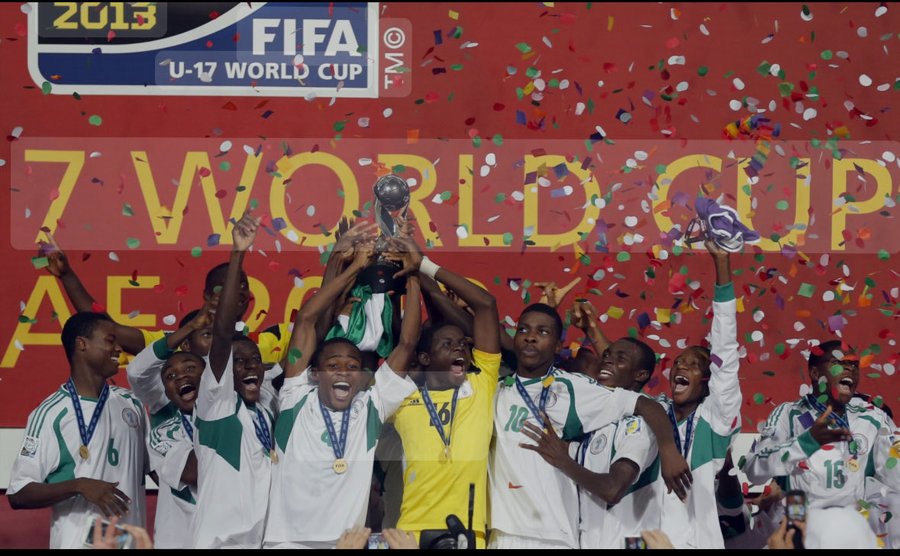


VINA DEL MAR, CHILE – NOVEMBER 08: Players of Nigeria celebrate with the trophy after winning the FIFA U-17 World Cup Chile 2015 Final between Mali and Nigeria at Estadio Sausalito on November 8, 2015 in Vina del Mar, Chile. (Photo by Alex Grimm – FIFA/FIFA via Getty Images) 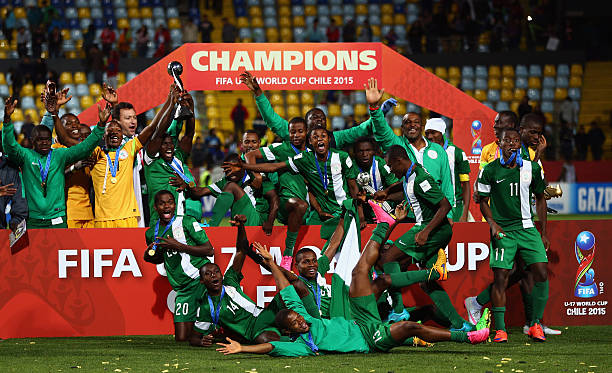
VINA DEL MAR, CHILE – NOVEMBER 08: Players of Nigeria celebrate with the trophy after winning the FIFA U-17 World Cup Chile 2015 Final between Mali and Nigeria at Estadio Sausalito on November 8, 2015 in Vina del Mar, Chile. (Photo by Alex Grimm – FIFA/FIFA via Getty Images)
“The enduring test of what you have achieved will be the future progress of these players,” Jonathan’s remarks at the State House in 2013 found renewed resonance then. “Their talent must be harnessed and developed to even greater success. You cannot afford to relax on today’s laurels, but must continue to train, guide, and care for them. This is a world-class team, and they must remain world champions from category to category and from one tournament to another.”
Twelve years have passed since the now-forgotten words of the former president, and ten since the triumph in Chile 2015. If 90 minutes is a long time in football, a decade-long stretch is more than enough for a shift in fortunes. Within that period, three World Cups have been held, and Nigeria has featured in only one: the 2019 edition in Brazil, where they crashed out in the round of 16 against the Netherlands.
The 2025 edition, which began in Qatar on November 3, is again conspicuously without the record champions, marking the first time the Golden Eaglets have missed two consecutive World Cups. Even more troubling is the fact that they were never in the race, having failed to contest at the 2025 U-17 AFCON, the gateway through which the top ten African nations now playing at the tournament booked their slots.
In simpler terms, the Golden Eaglets failed to qualify for the expanded 16-team U-17 AFCON, consequently missing out on the 10-nation African delegation at the 48-nation expanded World Cup ongoing in Qatar. Worse, the team will not be participating in next year’s U-17 AFCON either, after finishing third at the WAFU B U-17 Championship in October.
Some football enthusiasts have pointed to the regional qualification format as the problem, but Manu Garba blamed the Nigeria Football Federation (NFF), particularly for draining the players’ motivation by maintaining former president Amaju Pinnick’s no–match bonus policy. Ibrahim Gusau, the current NFF president, has reiterated a renewed commitment to reviving Nigeria’s youth football through talent development programmes in partnership with FIFA. For a man already in the final year of his term, such rhetoric carries little weight. This is an administration that has shown neither the interest nor the foresight to tackle these problems, if it even recognises them and their consequences at all.
The Overarching Decline of Nigeria’s Youth Football Sides
It’s not the best of times to be a Nigerian football fan. How can it be when the Super Eagles have failed to secure one of Africa’s nine automatic qualification tickets to the 2026 World Cup and still fumbled the second chance provided through the African playoffs, confirming their absence for a second consecutive time? It is hardly more reassuring watching the Super Falcons (laudable as their continental dominance may be) continue to stumble on the global stage. You see these and naturally long for better days, but the hope quickly fades when the realities within the nation’s cadet camps dawn on you.
Beyond the Eaglets, the Flying Eagles — Nigeria’s U-20 men’s team, whose ranks should ideally feed directly into the Super Eagles — have hardly impressed in recent times. They started the year fairly well, placing third at the 2025 U-20 AFCON to seal a World Cup spot in Chile. With a roster featuring Super Eagles invitees like Ebenezer Harcourt, the 16-year-old Sporting Lagos’ goalkeeper, the Flying Eagles went on to underperform at the World Cup, winning just one match before suffering a humiliating 4–0 loss to Argentina that ended their campaign. Meanwhile, Morocco went on to lift the title, their second of the year.

On the women’s side, the Flamingos, Nigeria’s U-17 team, exited the World Cup in October after a 4–0 defeat to Italy in the round of 16, having managed just one win in the group stage. This is from a side that claimed bronze in India in 2022 and reached the quarterfinals at the last edition in the Dominican Republic. It’s anyone’s guess whether the Falconets, the U-20 women’s side, will see out qualification for the 2026 U-20 World Cup and successfully defend their WAFU B title when the tournament begins on November 7.
However, in easing the undue pressure on the Bankole Olowookere-led side, it bears repeating that the essence of youth competitions is more about development and progression, and less about silverware. Then again, there is no more damning marker of Nigeria’s decline in youth and sports development than its failure in setting up its youth teams for this. No serious country or federation expects every youth outing to produce trophies. These are players at the fledgling stages of their careers; while winning team or individual laurels is desirable, it should never override the developmental purpose of these competitions.
It is, therefore, a painful reality when administrators remain tone-deaf to the significance of ensuring that these youth teams receive the support required to compete in key tournaments.
Super Eagles legend Samson Siasia, who has managed Nigeria at virtually every level in the men’s ranks, spoke to the foregoing in a 2024 appearance on ATHLS, a sports digital content studio.
“We were in hell, I tell you. Trust me, the easiest team to coach is the Super Eagles because they [the NFF] will give you everything that you need. But the Under-20s, even Under-16s, are the worst; you don’t even see food.
“If I didn’t begin early preparations, we wouldn’t have qualified for most of the competitions we did. Do you think it’s a joke? Most times, I leveraged my personal networks to secure accommodation. I bought them toiletries and gave them money from my own pocket. Do you think they were there for Nigeria? No, they were playing for me.”
"I spend my own money to make sure these boys are okay … I buy them toothpaste, brush and give them 100 100 dollars from my own pocket"
— @𝗼𝗻𝗲𝗷𝗼𝗯𝗹𝗲𝘀𝘀𝗯𝗼𝘆 (@OneJoblessBoy) April 21, 2024
– Samson Siasia pic.twitter.com/o7mTEbxG2C
Even if Siasia’s words must be taken cautiously, given his corruption scandal, current-day realities still point to the same structural dysfunction. The Eaglets remain a prime example. The NFF reappointed Garba (his fourth stint) as head coach less than two months before the WAFU B U-17 Championship in September. Unsurprisingly, the team could only manage a bronze medal finish, falling short of qualifying for the next AFCON. The same happened last year, with the same coach appointed less than four weeks before the start of the WAFU tournament in Ghana.
The outcome of this cyclical negligence is what has culminated in Nigeria missing the ongoing World Cup in Qatar. This pattern of appointing coaches only weeks before major tournaments has practically become the model across most of the nation’s youth sides. It is a ridiculous level of incompetence to keep recycling the same coaching crew based solely on past achievements. It is an even greater failure to rehire them at the last minute, leaving no time for proper preparation. Worse still, to do all these without providing adequate support or a functional structure for the teams is downright diabolical.
With each missed opportunity or poor outing, Nigeria continues to lose a potential crop of talent to the NFF’s ineptitude. Since there are no sustainable league or cadet structures catering to the development of teenage athletes nationwide, the few windows of opportunity that exist are often limited to these continental or global tournaments. Hence, these competitions have long served as launchpads for Nigerian youth athletes, providing the visibility that facilitates their progression to European ranks, where the structure and support needed to enhance their development are in abundance.
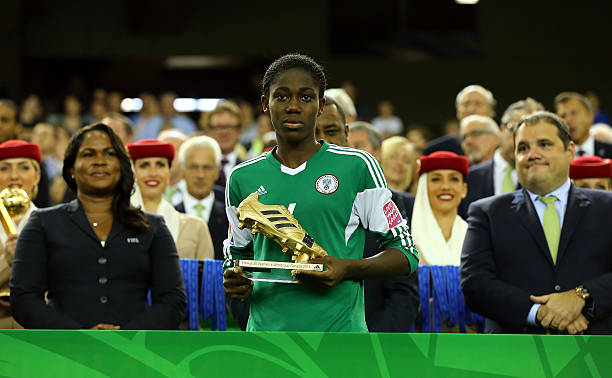
Asisat Oshoala, Osimhen, Chukwueze, Iheanacho, Awoniyi, and Nwakali (though all with varying fortunes today) are examples of players who caught the attention of European clubs through these tournaments. Can anyone categorically say these players would have enjoyed the same breakthroughs had they failed to participate in the World Cup editions they did? In the rare cases where such talented teenagers eventually come good, no one can tell how many vital developmental years they’ve already lost trying to make up for that missed exposure.
Like in every other sector where the youth are sabotaged, the stakes here are higher and the consequences more dire. NFF’s failure to properly manage youth football is already taking its toll on the senior national teams: for one, it’s largely why certain positions within the Super Eagles and Super Falcons lack adequate quality options.
As the most populous Black nation, with a predominantly young population, Nigeria possesses an abundant reservoir of raw football talent. Considering that football is by far the country’s popular sport of choice, it is a damning indictment of the NFF that sustainable development frameworks to harness this potential remain non-existent. The diasporan recruitment model that former President Pinnick popularised has proven to be little more than a band-aid for problems that a robust youth system will better address. How this overreliance on Europe-bred and diasporan players affects the country’s football identity is a discussion for another day.
What remains clear, however, is that if the local production line of talent is not properly maintained and nurtured, we might as well stop the charade altogether. After all, what good is a system that doesn’t pay much thought to its foundation?

